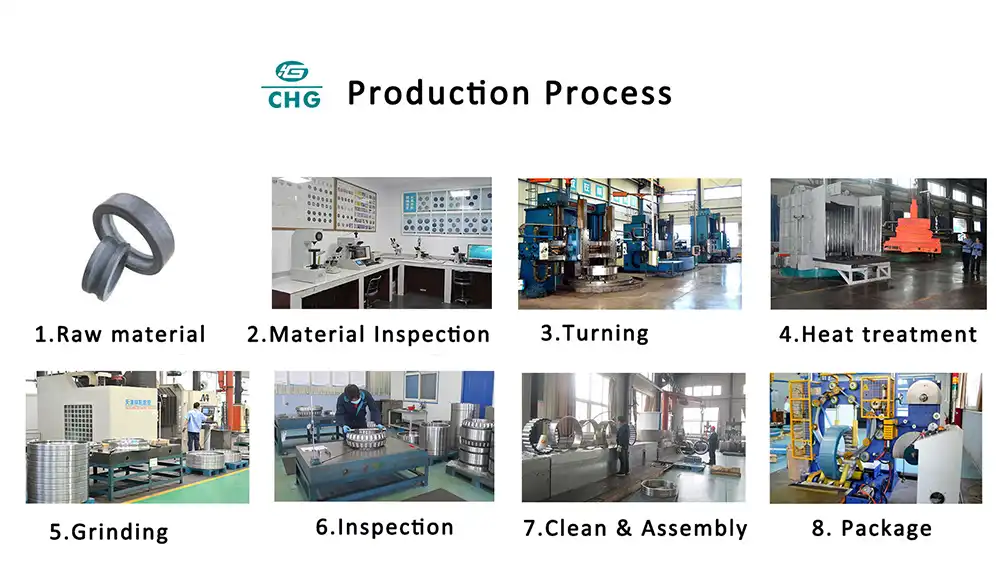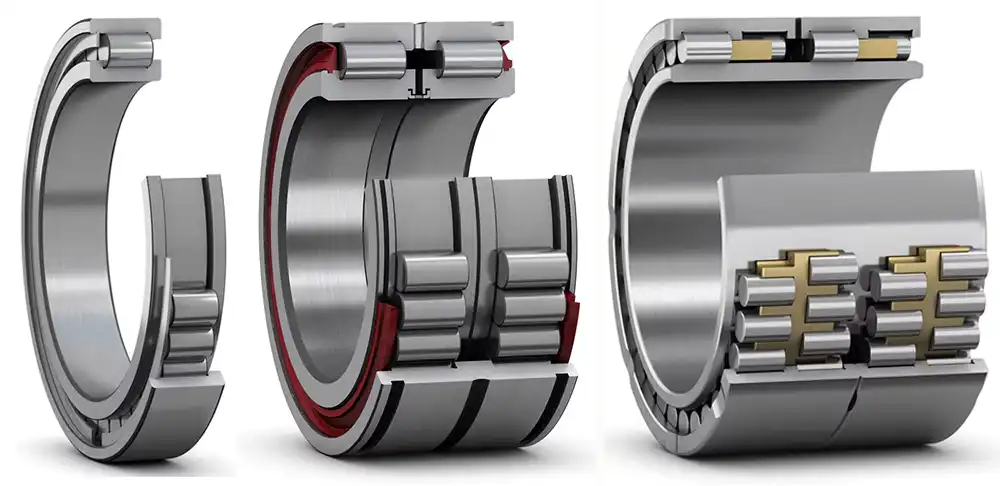What are the Advantages of Four Row Cylindrical Roller Bearings?
Four row cylindrical roller bearings are specialized rolling element bearings designed for applications requiring exceptional load capacity and precision. These components feature four rows of cylindrical rollers arranged to distribute loads effectively while maintaining rotational accuracy. As industrial machinery evolves toward higher performance demands, these bearings have become critical components in various heavy-duty applications. This article explores their advantages, applications, and technical considerations.

What makes four row cylindrical roller bearings ideal for heavy industrial applications?
Superior Load Distribution Capabilities
Four row cylindrical roller bearings excel in environments requiring substantial load-bearing capacity. Unlike conventional designs, the four row configuration distributes radial loads across multiple contact points, significantly enhancing the bearing's ability to handle extreme forces. In steel mills, where rolling stands must withstand continuous high-impact forces, these bearings provide necessary stability and durability. Their design incorporates precision-engineered cylindrical rollers that maintain line contact with raceways, maximizing the load-bearing surface area. This superior load distribution prevents localized stress concentrations that often lead to premature failure. Additionally, Four Row Cylindrical Roller Bearings feature optimized internal geometries that allow for thermal expansion without compromising operational integrity, further enhancing their suitability for applications where significant loads combine with temperature fluctuations.
Enhanced Radial Stiffness and Precision
The multiple row configuration contributes significantly to exceptional radial stiffness—a critical factor in precision machinery. By incorporating four separate rows of rollers, these bearings minimize deflection under load, maintaining precise shaft positioning even under substantial forces. This characteristic is particularly valuable in rolling mill operations, where dimensional accuracy directly impacts product quality. The enhanced stiffness of Four Row Cylindrical Roller Bearings also translates to reduced vibration levels, contributing to smoother operation and extended service life. The design typically incorporates high-precision cylindrical rollers manufactured to stringent tolerances, ensuring uniform load distribution and minimizing friction-related heat generation. Their inherent stiffness provides resistance against misalignment that might occur during operation due to structural deflections or thermal expansion, making them particularly suitable for applications where maintaining precise geometry is essential.
Optimized for Continuous Operation
Four Row Cylindrical Roller Bearings are engineered for environments requiring 24/7 operation with minimal maintenance. Their design incorporates advanced sealing systems that effectively prevent contamination in harsh industrial environments while retaining lubricant. This is particularly valuable in continuous casting operations where unplanned downtime carries substantial economic consequences. The roller and cage assemblies are optimized to minimize friction and heat generation during extended operation, contributing to overall energy efficiency. The arrangement of four roller rows allows for effective lubricant distribution throughout the bearing, ensuring all critical surfaces receive adequate lubrication during prolonged operating periods. These bearings typically offer extended relubrication intervals compared to conventional designs, reducing maintenance costs and opportunities for human error during service procedures. Their robust construction, often utilizing high-grade bearing steels and advanced heat treatment, provides exceptional resistance to fatigue, making them reliable components where continuous operation is essential.

How do four row cylindrical roller bearings improve equipment longevity and reliability?
Advanced Material Technology and Heat Treatment
The exceptional durability of Four Row Cylindrical Roller Bearings stems largely from advanced materials and specialized heat treatment processes. Manufacturers typically utilize high-chrome bearing steels with precisely controlled carbon content, optimized for specific operating conditions. These materials undergo sophisticated heat treatment protocols that develop microstructural characteristics essential for withstanding cyclic stresses. The resulting components exhibit exceptional hardness, dimensional stability, and resistance to rolling contact fatigue. Bearings for particularly demanding applications may incorporate additional material technologies such as bainitic hardening or specific carbide distributions to enhance performance. The races and rollers typically undergo multiple quality control processes, including ultrasonic testing, to ensure material homogeneity and detect subsurface flaws. Advanced surface finishing techniques, including superfinishing and isotropic finishing, reduce friction coefficients and enhance the bearing's ability to develop effective lubrication films. These material and processing advantages collectively contribute to the exceptional service life that properly selected and maintained Four Row Cylindrical Roller Bearings provide.
Specialized Sealing and Lubrication Systems
Four Row Cylindrical Roller Bearings incorporate sophisticated sealing and lubrication solutions that significantly contribute to operational longevity. The sealing systems typically employ multiple barriers against contaminants, often including labyrinth designs, contact seals, and specialized housing features that collectively prevent ingress of abrasive particles and moisture. These protection mechanisms are critical in environments such as steel mills, where bearings may be exposed to scale, cooling water, and other contaminants. Lubrication systems are engineered to deliver precise quantities of lubricant to all critical surfaces, optimizing the formation of elastohydrodynamic films that separate rolling elements from raceways during operation. Modern installations often incorporate automated lubrication systems with monitoring capabilities, ensuring consistent lubricant delivery while providing early warning of potential issues. The bearing design typically includes optimized internal geometries that promote effective lubricant circulation, preventing starvation even in challenging operating positions. Specialized lubricant formulations with enhanced extreme pressure additives and oxidation stability are commonly specified, further extending service life in demanding applications.
Reduced Maintenance Requirements and Downtime
One of the most significant economic advantages of Four Row Cylindrical Roller Bearings is their ability to reduce maintenance frequency and associated production interruptions. Their robust design and substantial load capacity typically translate to extended service intervals compared to conventional configurations carrying similar loads. This is particularly valuable in continuous process industries where production stoppages carry substantial financial implications. These bearings often incorporate features that facilitate condition monitoring, including provisions for temperature sensors, vibration monitoring, and lubricant sampling. These capabilities enable predictive maintenance approaches rather than fixed-interval replacements, optimizing maintenance resources while minimizing unexpected failures. The design typically allows for relatively straightforward replacement procedures when maintenance is eventually required, with standardized dimensions and mounting practices facilitating efficient service operations. Many Four Row Cylindrical Roller Bearings are designed with serviceability in mind, incorporating features that allow for in-situ inspection and, in some cases, reconditioning without complete disassembly of associated equipment. The economic benefits extend beyond direct labor and parts costs to include significant value from avoided production losses.

What are the key specifications to consider when selecting four row cylindrical roller bearings?
Load Ratings and Dimensional Considerations
When selecting Four Row Cylindrical Roller Bearings, engineers must evaluate both static and dynamic load ratings in relation to anticipated operating conditions. The static load rating reflects the bearing's ability to withstand heavy loads while stationary without permanent deformation, while the dynamic rating indicates the load at which the bearing will achieve a specified design life under ideal conditions. These ratings must be considered alongside application factors that account for shock loading, vibration, and other real-world conditions. Dimensional considerations extend beyond basic bore, outside diameter, and width specifications to include internal clearances, selected based on operating temperatures and interference fits. These bearings are available in various configurations, including designs with separable rings that facilitate installation in complex assemblies. Engineers must consider the relationship between the bearing's dimensions and available space, as well as implications for shaft and housing designs, including appropriate fits and tolerances. The precision class selection represents another critical specification, with applications requiring exceptional running accuracy typically demanding bearings manufactured to higher tolerance classes.
Speed Limitations and Thermal Considerations
Four Row Cylindrical Roller Bearings must be carefully evaluated regarding their speed capabilities and thermal behavior. The permissible rotational speed is influenced by several factors, including dimensions, cage design, lubrication method, and cooling provisions. Engineers must analyze the relationship between the application's required speed and the bearing's limiting speed, which represents the maximum rotational velocity at which the bearing can operate reliably. In high-speed applications, specialized cage designs may be required to ensure stable operation. Thermal considerations are equally critical, as operating temperature affects internal clearances, lubricant performance, and service life. Heat generation results primarily from rolling friction, sliding friction between rollers and cage pockets, and lubricant churning. Applications involving elevated speeds often require enhanced cooling provisions, which might include circulating lubrication systems with heat exchangers. Thermal expansion characteristics must be considered during installation, particularly regarding the selection of appropriate fits that account for differential expansion between bearing components and associated structures. Modern computational tools allow engineers to model the thermal behavior under specific operating conditions, optimizing selections to balance load capacity, speed capability, and thermal management.
Mounting and Installation Requirements
Successful implementation of Four Row Cylindrical Roller Bearings depends significantly on proper mounting and installation practices. These substantial components typically require specialized equipment, including induction heaters for thermal mounting methods or hydraulic tools for interference fit applications. Engineers must establish detailed installation procedures that specify mounting forces, heating temperatures, and alignment verification methods to ensure the bearing is not damaged during installation and achieves intended positional accuracy. The substantial dimensions and weight necessitate appropriate handling equipment and fixtures to prevent damage and ensure worker safety. Alignment requirements are particularly stringent, as their exceptional load capacity is optimized when loads are distributed uniformly across all rollers—a condition requiring precise shaft-to-housing alignment. Installation specifications typically include detailed requirements for supporting structures, as substantial loads transmitted through these bearings necessitate adequately rigid housing and foundation designs to prevent secondary failures resulting from excessive deflection under load. Proper documentation of installation parameters provides valuable reference information for future maintenance operations and troubleshooting activities.

Conclusion
Four row cylindrical roller bearings offer unmatched advantages in heavy industrial applications, combining exceptional load capacity with precision and durability. Their superior design enables optimal load distribution, enhanced radial stiffness, and continuous operation capabilities. With advanced materials, specialized sealing systems, and reduced maintenance requirements, these bearings significantly improve equipment longevity and reliability. When selecting these bearings, engineers must carefully consider load ratings, speed limitations, and installation requirements to maximize performance. These considerations ensure that four row cylindrical roller bearings deliver their full potential in demanding industrial environments.

Luoyang Huigong Bearing Technology Co., Ltd. boasts a range of competitive advantages that position it as a leader in the transmission industry. Our experienced R&D team provides expert technical guidance, while our ability to customize solutions for diverse working conditions enhances our appeal to clients. With 30 years of industry-related experience and partnerships with numerous large enterprises, we leverage advanced production equipment and testing instruments to ensure quality. Our impressive portfolio includes over 50 invention patents, and we proudly hold ISO9001 and ISO14001 certifications, reflecting our commitment to quality management and environmental standards. Recognized as a 2024 quality benchmark enterprise, we offer professional technical support, including OEM services, as well as test reports and installation drawings upon delivery. Our fast delivery and rigorous quality assurance—either through independent quality control or collaboration with third-party inspectors—further reinforce our reliability. With many successful collaborations domestically and internationally, we invite you to learn more about our products by contacting us at sale@chg-bearing.com or calling our hotline at +86-0379-65793878.
References
1. Johnson, K.L. (2023). Contact Mechanics and Rolling Element Bearings: Advanced Applications of Four Row Cylindrical Roller Bearings. Journal of Tribology, 145(3), 238-251.
2. Zhang, H., & Liu, W. (2022). Thermal Behavior Analysis of Four Row Cylindrical Roller Bearings in High-Speed Applications. Tribology International, 167, 107-119.
3. Takemura, H., & Smith, J. (2023). Computational Modeling for Load Distribution in Four Row Cylindrical Roller Bearings. Engineering Failure Analysis, 142, 105-118.
4. Chen, W., & Rodrigues, A. (2021). Advancements in Material Technology for Four Row Cylindrical Roller Bearings in Heavy Industry. Wear, 473, 203-217.
5. Müller, F., & Kumar, S. (2022). Sealing Technologies for Four Row Cylindrical Roller Bearings in Contaminated Environments. Tribology Transactions, 65(1), 128-142.
6. Patel, R., & Yamamoto, Y. (2024). Service Life Prediction Models for Four Row Cylindrical Roller Bearings in Rolling Mill Applications. International Journal of Fatigue, 169, 177-192.

